洞察
Integrated Solutions
Rooted in the Patient Experience
Across the Product Life Cycle
Related Articles
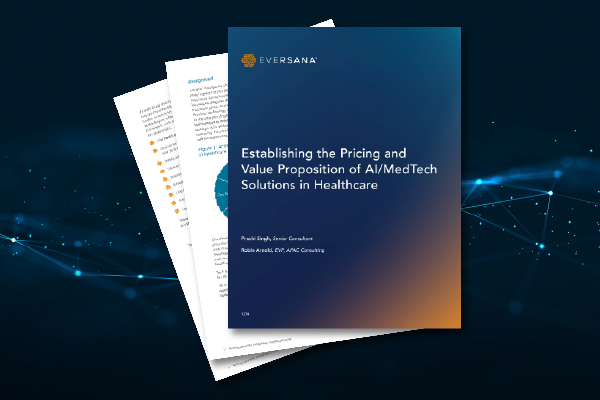
Establishing the Pricing and Value Proposition of AI/MedTech Solutions in Healthcare
Authors: Prachi Singh, Senior Consultant; Robin Arnold, EVP, APAC Consulting Unlock the future of healthcare with our white paper, “Establishing the Pricing and Value Proposition of AI/MedTech Solutions in Healthcare.” Discover the essential components of pricing AI/MedTech solutions and crafting compelling value propositions that resonate with stakeholders, including payers, patients, and physicians. Explore real-world examples, such as AI in breast cancer screening, to understand the complexities of pricing models and the significance of local evidence in driving successful adoption. With a comprehensive analysis of performance, validation, usability, regulatory compliance and cost-savings, this white paper equips you with the knowledge to navigate the evolving landscape of healthcare technology. Complete the form […]
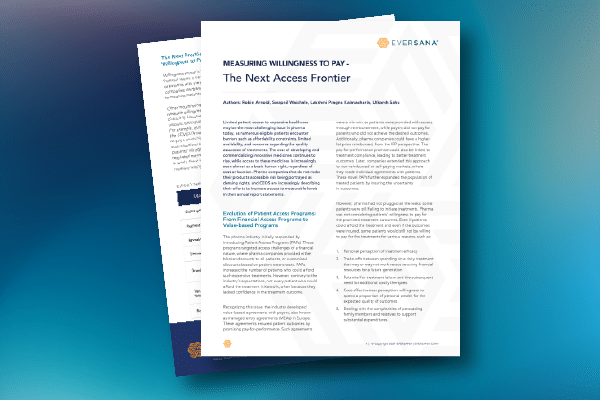
Measuring Willingness to Pay: The Next Access Frontier
EVERSANA’s APAC Team Authors: Robin Arnold, Swapnil Waichale, Lakshmi Pragna Kalavacharla, Utkarsh Sahu Patient access to expensive healthcare poses a significant challenge in the pharmaceutical industry. As the cost of developing innovative medicines rises, the demand for accessibility as a basic human right increases. This POV explores the evolution of Patient Access Programs (PAPs) from financial to value-based models, emphasizing the need to address patient willingness to pay for treatments. Despite financial accessibility assurances, some patients still hesitate due to various factors, prompting the need to measure willingness to pay independently of financial status. This POV delves into the complexities of assessing willingness to pay and highlights the lack of […]
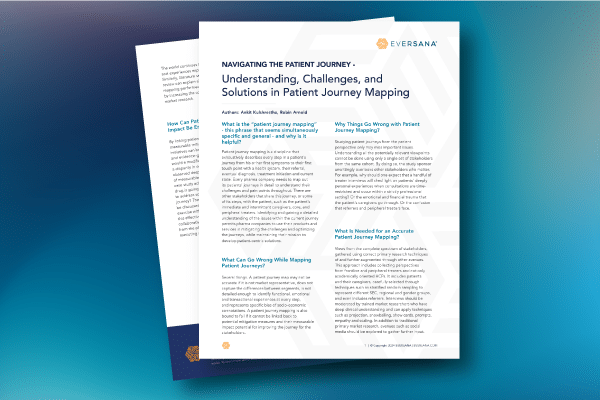
Navigating the Patient Journey: Understanding, Challenges, and Solutions in Patient Journey Mapping
EVERSANA’s APAC Authors: Ankit Kulshrestha, Robin Arnold This POV explores the intricacies of Patient Journey Mapping, detailing its significance, challenges, and solutions. Patient journey mapping is a comprehensive discipline that traces a patient’s entire healthcare journey, from initial symptoms to treatment and beyond. Understanding this journey is imperative for pharmaceutical companies, enabling them to address challenges and optimize patient-centric solutions. The document highlights potential pitfalls in mapping patient journeys, emphasizing the need for market representation, segment differentiation, and a detailed examination of functional, emotional, and transactional experiences. Failure to link mapping to actionable mitigation measures poses a significant risk. Examining patient journeys solely from the patient’s perspective overlooks crucial viewpoints from […]
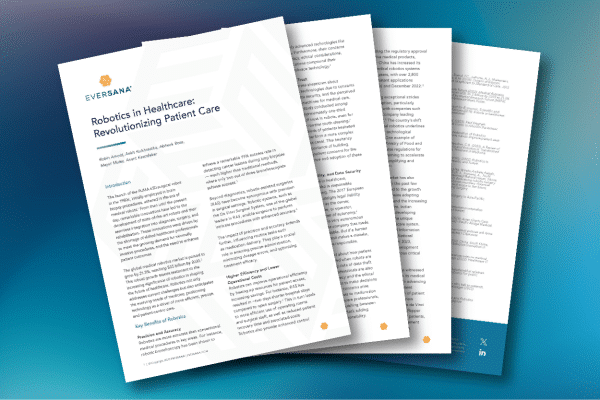
Robotics in Healthcare: Revolutionizing Patient Care
Authors: Robin Arnold, Ankit Kulshrestha, Abheek Bose, Mayur Muley, Anant Kasodekar The launch of the PUMA 650 surgical robot in the 1980s, initially employed in brain biopsy procedures, ushered in the era of medical robots.1 From then until the present day, remarkable innovations have led to the development of state-of-the-art robots and their seamless integration into diagnosis, surgery, and rehabilitation. These innovations were driven by the shortage of skilled healthcare professionals to meet the growing demand for minimally invasive procedures, and the need to enhance patient outcomes. The global medical robotics market is poised to grow by 21.3%, reaching $35 billion by 2030.2 This robust growth stands testament to the […]
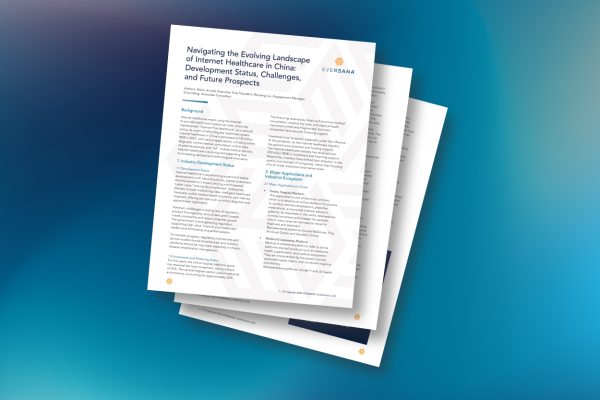
Navigating the Evolving Landscape of Internet Healthcare in China: Development Status, Challenges, and Future Prospects
Authors: Robin Arnold, Executive Vice President; Renyang Liu, Engagement Manager; Erica Wang, Associate Consultant Background Internet healthcare means using the internet to provide health and medical services. China has implemented “Internet Plus Healthcare” as a national policy, as a part of reforming the healthcare system. Internet healthcare in China is estimated at 150 billion RMB in 2023, with various applications, including online diagnosis, online medical consultation, online sales of pharmaceuticals, and “IoT” mobile medical devices. Internet healthcare is evolving and expanding due to increasing demand and technological innovation. Complete the form below to download the full article.
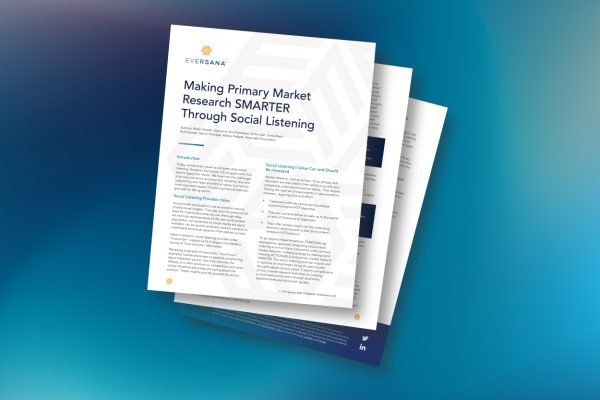
Making Primary Market Research SMARTER Through Social Listening
Discover how EVERSANA is transforming the landscape of primary market research in the pharmaceutical industry through our unique approach to social listening. This insightful article from our APAC team highlights the common challenges faced by pharma companies and how most fall short in translating social insights into actionable strategies. EVERSANA, on the other hand, stands out by making social listening truly actionable. Learn how we seamlessly integrate social insights into primary market research, creating a powerful synergy that delivers tangible results for their clients. Don’t miss the opportunity to gain valuable insights into this game-changing approach – download and read the full article now! Complete the form below to download […]
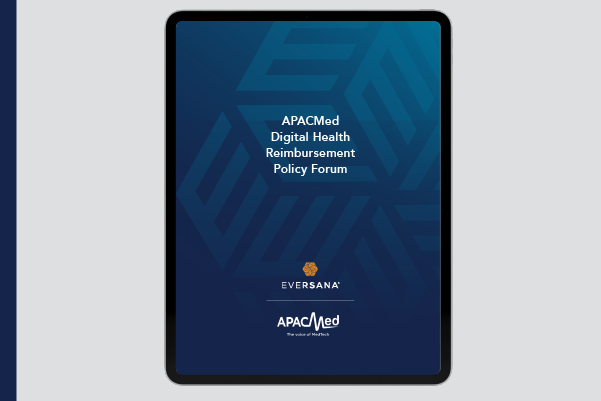
APACMed Digital Health Reimbursement Policy Forum
Introduction The APACMed Policy Forum on Digital Health Reimbursement was held on 23 May 2023, with participants from Australia, Japan, Singapore, South Korea, Germany, France, and the UK. Several digital health policymakers, academicians, and experts from the respective countries, along with the APACMed Digital Health Reimbursement Alliance (DHRA) core committee, local trade associations, and EVERSANA members participated in the event. The forum was structured across three sessions: Session 1: Background on the digital health landscape across APAC, US, and Europe Session 2: Key learnings from APAC and Europe in the digital health reimbursement area Session 3: Scenario-based case discussion on an imaginary digital therapeutic product The policymakers shared the current […]
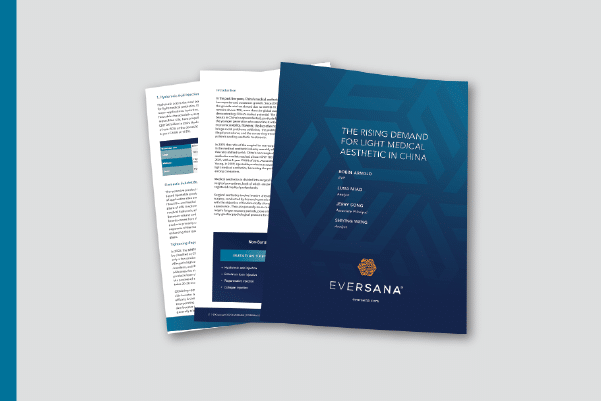
The Rising Demand for Light Medical Aesthetic in China
“The Rising Demand for Light Medical Aesthetic in China” provides a captivating insight into the surging popularity of non-surgical medical aesthetics in China. The article highlights the rapid growth of the medical aesthetic market and the shifting trends in consumer preferences. It delves into the key contributors and experts driving this industry and examines the challenges posed by the pursuit of beauty, such as addiction and illegal procedures. The comprehensive analysis showcases the dominance of hyaluronic acid injection as the preferred choice among consumers and delves into its various applications and future trends. Furthermore, the article explores the potential of botulinum toxin injection and regenerative injections, shedding light on their […]
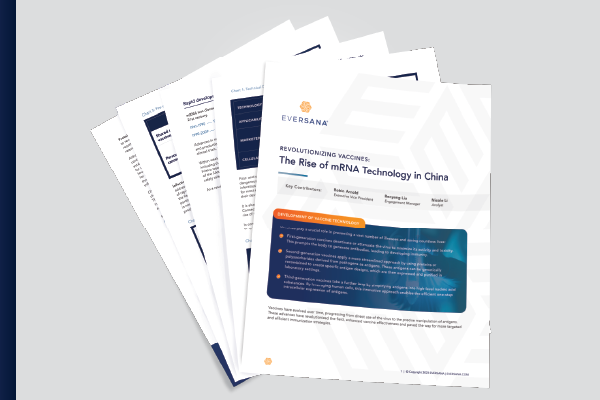
Revolutionizing Vaccines: The Rise of mRNA Technology in China
Key Contributors: Robin Arnold, Executive Vice President; Renyang Liu, Engagement Manager; Nicole Li, Analyst Discover how mRNA technology is transforming the field of vaccines in China. From the evolution of vaccine development to the rapid progress of mRNA vaccines during the COVID-19 pandemic, this article explores the advantages of mRNA vaccines compared to conventional ones. Delve into the efforts of Chinese pharmaceutical companies to develop mRNA vaccines, overcoming policy barriers and seeking international markets. Learn about the potential applications of mRNA vaccines in areas like cancer immunotherapy and infectious diseases. Don’t miss the opportunity to explore the future of vaccines and how China is striving to develop safer and more […]
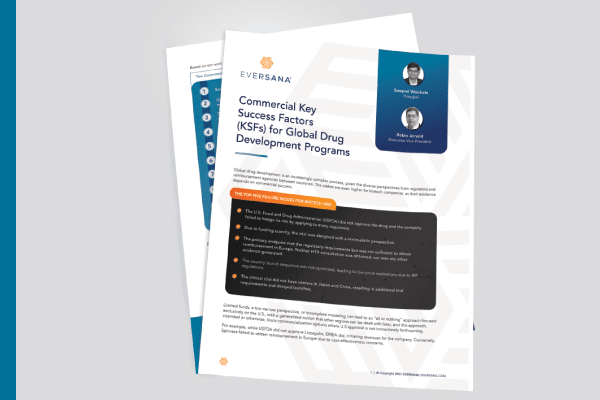
Commercial Key Success Factors (KSFs) for Global Drug Development Programs
Key Contributors: Swapnil Waichale, Principal and Robin Arnold, Executive Vice President Discover the essential commercial key success Factors (KSFs) that drive triumph in global drug development programs. In an era of diverse regulatory perspectives and reimbursement complexities, biotech companies face higher stakes than ever before. Swapnil Waichale and Robin Arnold unveil the top failure modes for biotech firms and present a groundbreaking set of ten KSFs that can revolutionize the path to commercial success. From securing parallel consultations with regulatory and HTA authorities to optimizing country launch sequences, these strategies are the keys to unlocking global opportunities and maximizing profitability. Dive into this enlightening article and position your drug development […]
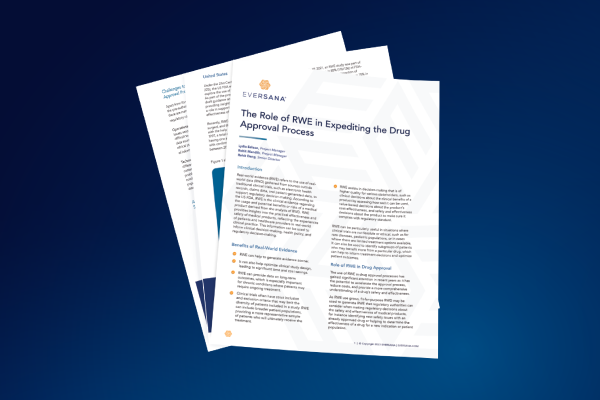
The Role of RWE in Expediting the Drug Approval Process
Key Contributors: Lydia Edison (Project Manager), Rohit Mandlik (Project Manager), Rohit Dang (Engagement Manager), Mahendra Rai (Senior Director) The role of real-world evidence (RWE) in expediting the drug approval process. RWE refers to the use of real-world data (RWD) from sources outside traditional clinical trials to support regulatory decision-making. RWE offers several benefits, including generating evidence sooner, optimizing clinical study design, providing data on long-term outcomes, including diverse patient populations, and improving decision-making for stakeholders. The use of RWE in drug approval processes has gained significant attention, with the US FDA establishing an RWE program to explore its potential. RWE-supported approvals have increased over the years, demonstrating its growing significance. […]
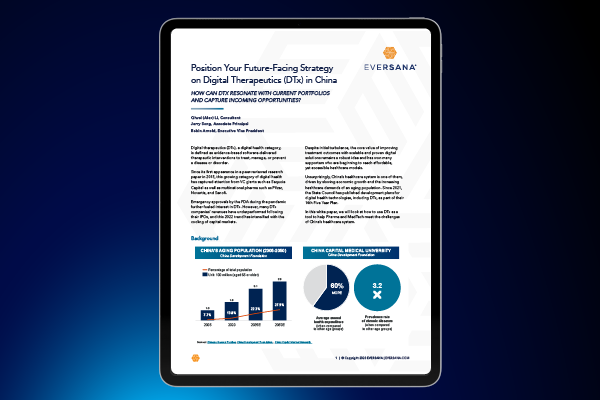
Position Your Future-Facing Strategy on Digital Therapeutics (DTx) in China
How can DTx resonate with current portfolios and capture incoming opportunities? Key Contributors: Robin Arnold, Executive Vice President; Jerry Song, Associate Principal; Qiwei (Alex) Li, Consultant The article discusses the potential of digital therapeutics (DTx) in China’s healthcare system and how it can help pharmaceutical and medical technology companies address the challenges presented by the country’s aging population and healthcare demands. China’s aging population, which is expected to reach 22% by 2035 and 28% by 2050, presents opportunities for healthcare companies to provide health management solutions for chronic diseases. However, challenges include limited healthcare awareness among patients, geographical gaps in healthcare providers, immense pressures in market access, and difficulties in extending at-home […]
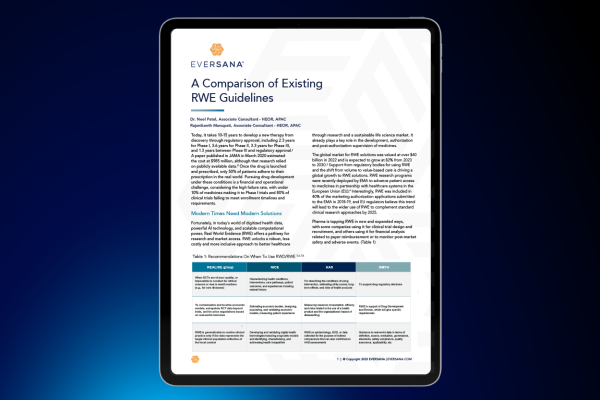
A Comparison of Existing Real World Evidence (RWE) Guidelines
Key Contributors: Neel Patel, Associate Consultant- HEOR, APAC and Rajanikanth Manupati, Associate Consultant- HEOR, APAC In the fast-paced world of healthcare, where the development and approval of new therapies can take over a decade, the need for modern solutions is more pressing than ever. Enter Real World Evidence (RWE) – a game-changing approach that harnesses the power of digitized health data, artificial intelligence, and scalable computational power to revolutionize research and market access. With its potential to offer a robust, cost-effective, and inclusive pathway for better healthcare, RWE is gaining momentum worldwide. Regulatory bodies, such as the European Medicines Agency (EMA), are increasingly embracing RWE, with expectations of wider adoption […]
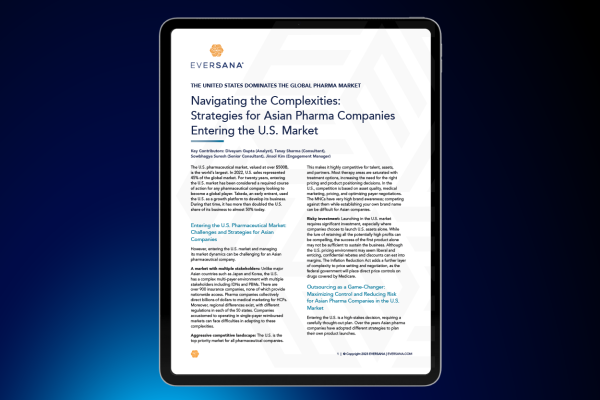
Navigating the Complexities: Strategies for Asian Pharma Companies Entering the U.S. Market
Key Contributors: Divayum Gupta (Analyst), Tanay Sharma (Consultant), Sowbhagya Suresh (Senior Consultant), Jinsol Kim (Engagement Manager) The United States holds a dominant position in the global pharmaceutical market, accounting for 45% of global sales in 2022. However, Asian pharmaceutical companies face significant challenges when entering the complex U.S. market. The U.S. healthcare system involves multiple stakeholders and a complex multi-payer environment, with regional differences and varying regulations across the 50 states. Additionally, the U.S. market is highly competitive, making it difficult for Asian companies to establish their brand names and compete against multinational corporations. Furthermore, launching in the U.S. market requires substantial investment, and the pricing environment is complex, with […]
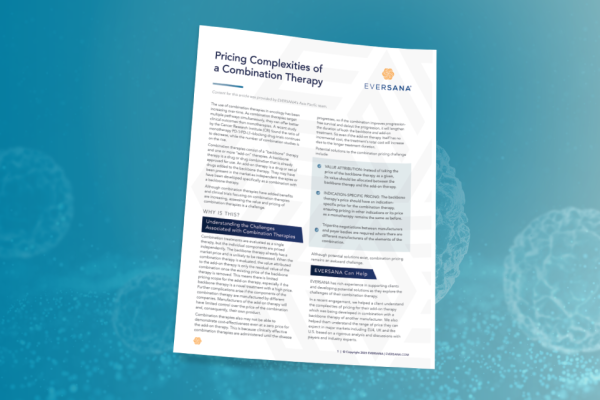
Pricing Complexities of a Combination Therapy
This article, authored by EVERSANA’s Asia Pacific team, discusses the increasing use of combination therapies in oncology and the challenges associated with pricing them. Combination therapies, which involve a backbone therapy and one or more add-on therapies, offer better clinical outcomes but pose difficulties in determining their value and pricing. One challenge arises from the fact that combination treatments are evaluated as a single therapy, but the individual components are priced independently. The value attributed to the add-on therapy is limited as it is calculated based on the residual value of the combination after removing the price of the backbone therapy. Additionally, combination therapies may not demonstrate cost-effectiveness even if the […]

2023 Outlook Of China Healthcare Industry: Remaining Pragmatic While Moving Up The Value Chain
As we enter 2023, China surprised the world with a swift and decisive shift in COVID policy, demonstrating the country’s ability to be flexible and pragmatic in its decision-making. In contrast to Russia’s persistent adherence to ideologies, China demonstrated its willingness to pivot quickly when necessary. The 14th Five-Year Plan at the 20th National Congress last November emphasized words like “innovation,” “science and technology,” and “international,” setting the foundation for a long-term scheme to construct a new global order. China’s ambition to lead this new order by dominating critical sciences and technologies sectors, rather than serving as outsourced labor for foreign companies, marks a shift towards targeting a higher-value position […]
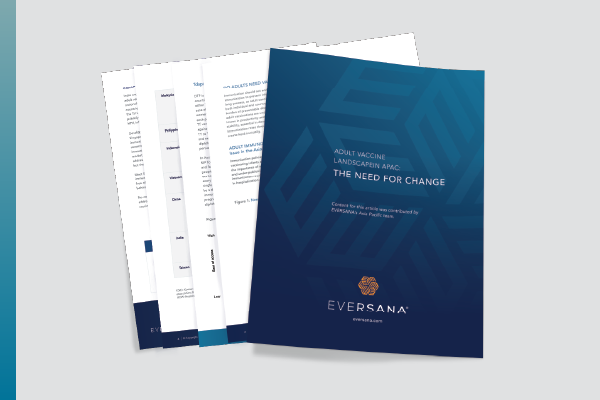
Adult Vaccine Landscape in APAC: The Need for Change
Content for this article was contributed by EVERSANA’s Asia Pacific team. Do Adults Need Vaccines? Immunization should not end with adulthood. Using immunization to prevent infection should be a life-long process, as adult vaccination provides benefits at both individual and country levels, reducing the overall burden of preventable diseases. However, in practice, adult vaccinations are underused. Adult vaccines prevent losses in productivity and help maintain socio-economic stability, essential in developing countries. Higher immunization rates through adult vaccination also help to create herd immunity. Adult Immunization: A Neglected Issue in the Asia Pacific Region Immunization policies in APAC are primarily directed at vaccinating infants and children. This focus overlooks the importance […]
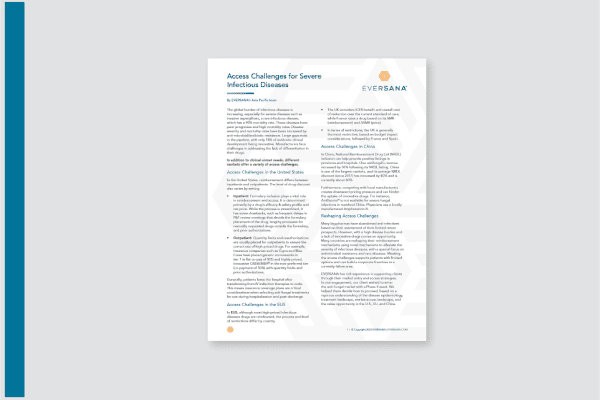
Access Challenges for Severe Infectious Diseases
Content for this article was provided by EVERSANA’s Asia Pacific team. The global burden of infectious diseases is increasing, especially for severe diseases such as invasive aspergillosis, a rare infectious disease, which has a 90% mortality rate. These diseases have poor prognoses and high mortality rates. Disease severity and mortality rates have been increased by anti-microbial/antibiotic resistance. Large gaps exist in the pipeline, with only 18% of antibiotic clinical development being innovative. Manufacturers face challenges in addressing the lack of differentiation in their drugs. In addition to clinical unmet needs, different markets offer a variety of access challenges. Complete the form below to learn more about US, EU5 and APAC […]
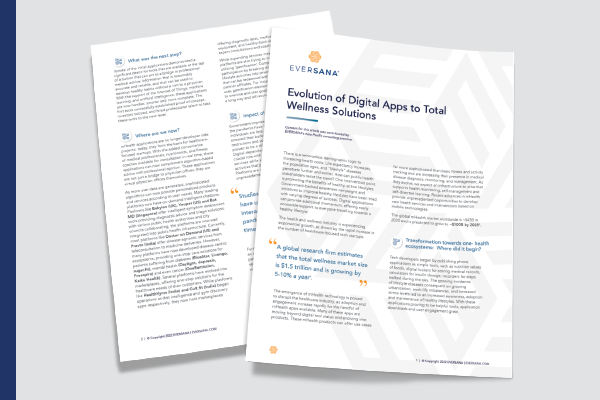
Evolution of Digital Apps to Total Wellness Solutions
Content for this article was contributed by EVERSANA’s Asia Pacific consulting practice. There is a remorseless demographic logic to increasing health costs. Life expectancy increases, the population ages, and “lifestyle” diseases penetrate further and earlier. How can public health stakeholders resist the trend? One intervention point is promoting the benefits of healthy, active lifestyles. Government-backed awareness campaigns and initiatives to improve healthy lifestyles have been tried with varying degrees of success. Digital applications can provide additional momentum, offering easily accessible support to everyone travelling towards a healthy lifestyle. The health and wellness industry is experiencing exponential growth, as shown by the rapid increase in the number of healthcare-focused tech startups. […]
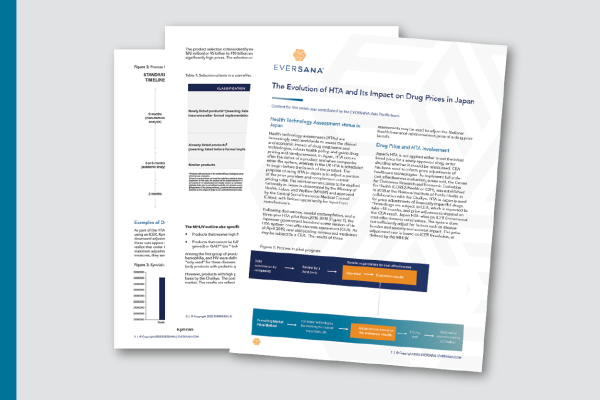
The Evolution of HTA and Its Impact on Drug Prices in Japan
Health Technology Assessment Status in Japan Health technology assessments (HTAs) are increasingly used worldwide to assess the clinical and economic impact of drug treatments and technologies, inform health policy, and guide drug pricing and reimbursement. In Japan, HTA occurs after the debut of a product and when companies enter the system, whereas in the UK HTA is scheduled to begin before the launch of the product. The purpose of using HTA in Japan is to adjust a portion of the price premium and complement current pricing rules. The reimbursement price to be applied nationally in Japan is determined by the Ministry of Health, Labor, and Welfare (MHLW) and approved by […]
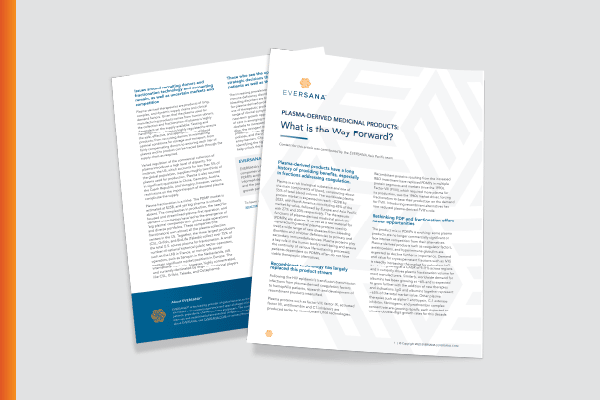
Plasma derived medicinal products – What is the way forward?
Content for this article was contributed by the EVERSANA Asia Pacific team. Plasma-derived products have a long history of providing benefits, especially in fractions addressing coagulation. Plasma is a rich biological substance and one of the main components of blood, constituting about 55% of total blood volume. The worldwide plasma protein market is expected to reach ~$29B by 2023, with North America constituting 45% of the market by value, followed by Europe and Asia Pacific with 27% and 20% respectively. The therapeutic functions of plasma-derived medicinal products (PDMPs) are diverse. It serves as a raw material for manufacturing several plasma proteins used to treat a wide range of rare diseases […]
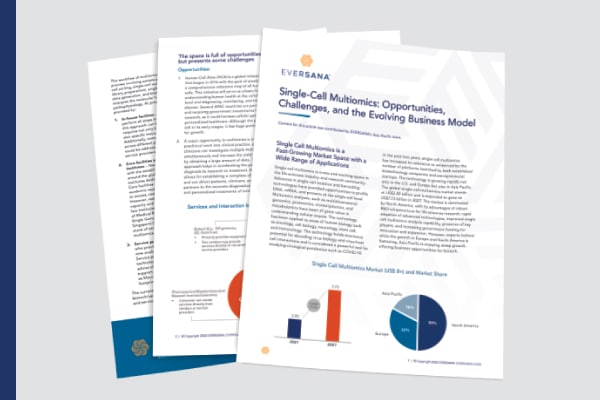
Single-Cell Multiomics: Opportunities, Challenges, and the Evolving Business Model
Content for this article was contributed by EVERSANA’s Asia Pacific team. Single Cell Multiomics is a Fast-Growing Market Space with a Wide Range of Applications Single cell multiomics is a new and exciting space in the life sciences industry and research community. Advances in single-cell isolation and barcoding technologies have provided opportunities to profile DNA, mRNA, and proteins at the single-cell level. Multiomics analyses, such as multidimensional genomics, proteomics, transcriptomics, and metabolomics have been of great value in understanding cellular events. The technology has been applied to areas of human biology such as oncology, cell biology, neurology, stem cell, and immunology. The technology holds enormous potential for decoding virus biology […]
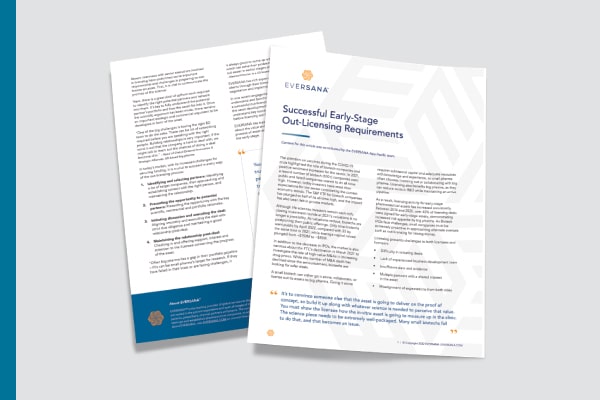
Successful Early-Stage Out-Licensing Requirements
The attention on vaccines during the COVID-19 crisis highlighted the role of biotech companies and positive sentiment increased for the sector. In 2021, a record number of biotech (100+) companies went public and listed companies soared to an all-time high. However, today investors have reset their expectations for the sector considering the current economic trends. The S&P ETF for biotech companies has plunged to half of its all-time high, and the impact has also been felt in private markets. Although life sciences investors remain cash-rich, closing investment rounds at 2021’s valuations is no longer a possibility. As valuations reduce, biotechs are postponing their public offerings. Only nine biotechs went public […]
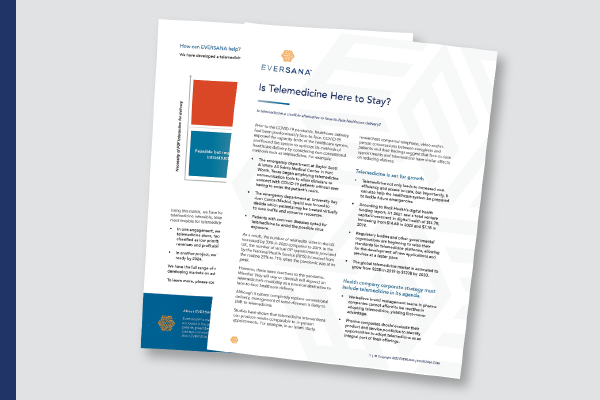
Is Telemedicine Here to Stay?
Prior to the COVID-19 pandemic, healthcare delivery had been predominantly face-to-face. COVID-19 exposed the capacity limits of the healthcare system, and forced the system to optimize its methods of healthcare delivery by considering non-conventional methods such as telemedicine. Download our article to learn how our telemedicine matrix can inform companies’ mid-to-long term brand strategies.
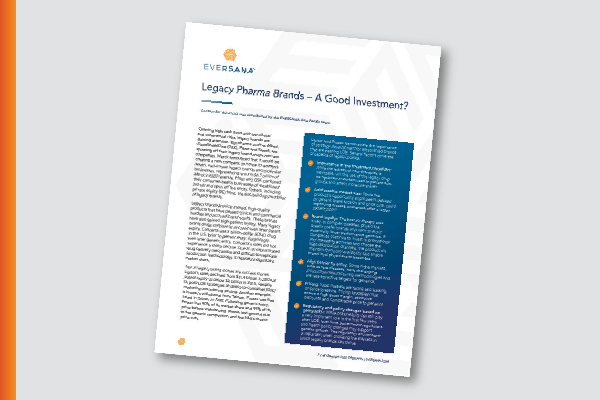
Established Pharma Brands – A Good Investment?
Offering high cash flows with low clinical and commercial risks, established brands are gaining attention. Big pharma, such as Merck, GlaxoSmithKline (GSK), Pfizer and Sanofi, are spinning off their established brand drugs into new companies. Merck announced that it would be creating a new company, to house its women’s health, well-known established brands and biosimilar businesses, representing around $6.5 billion of Merck’s 2020 revenue. Pfizer and GSK combined their consumer-health businesses of established brands and spun off the entity. Others, including private equity (PE) firms, are also building portfolios of established brands. Established brands provide trusted, high-quality products that have passed clinical and commercial hurdles and accrued brand equity. These […]
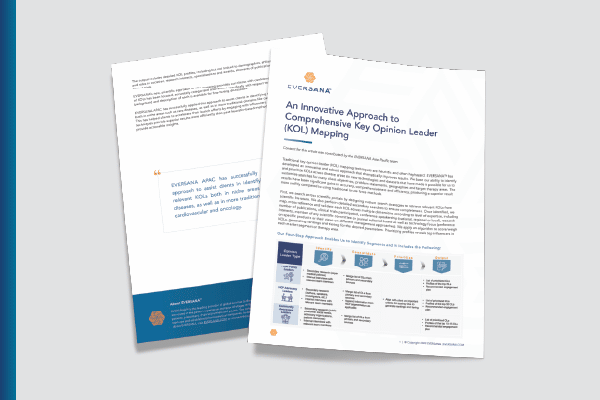
An Innovative Approach to Comprehensive Key Opinion Leader (KOL) Mapping
Traditional key opinion leader (KOL) mapping techniques are heuristic and often haphazard: EVERSANA™ has developed an innovative and robust approach that dramatically improves results. We base our ability to identify and prioritize KOLs across disease areas on new technologies and datasets that have made it possible for us to customize searches for many client objectives, problem statements, geographies and target therapy areas. The results have been significant gains in accuracy, comprehensiveness and efficiency, producing a superior result more swiftly compared to using traditional brute force methods.
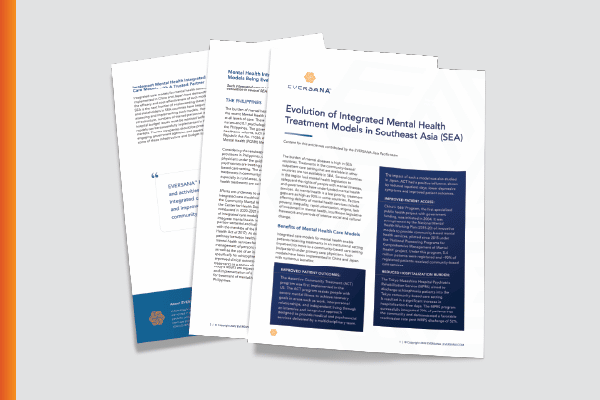
Evolution of Integrated Mental Health Treatment Models in Southeast Asia (SEA)
Implement Mental Health Integrated Care Models with A Trusted Partner Integrated-care models for mental health conditions implemented in China and Japan have demonstrated the efficacy and cost-effectiveness of such models. SEA is the next frontier of implementing these models and stakeholders in SEA countries have begun assessing and implementing such models. However, infrastructure, numbers of trained personnel and hospital budget issues must be resolved before these models can be successfully implemented in these markets. Pharma companies should be proactive in engaging government agencies and payers to resolve some of these infrastructure and budget issues. Complete the form below and download our article to learn more about the care models that […]
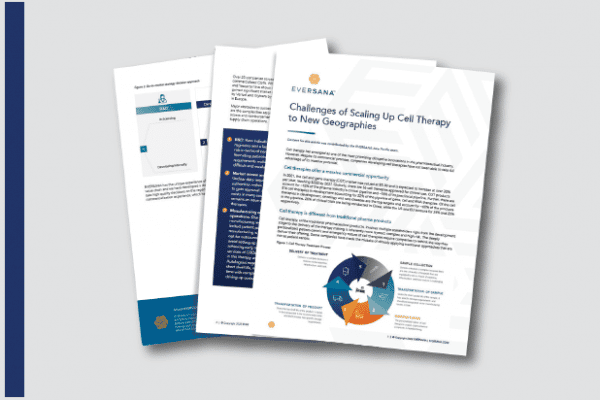
Challenges of Scaling Up Cell Therapy to New Geographies
Cell therapy has emerged as one of the most promising disruptive innovations in the pharmaceutical industry. However, despite its commercial promise, companies developing cell therapies have not been able to take full advantage of its massive potential. Cell therapies offer a massive commercial opportunity In 2021, the cell and gene therapy (CGT) market was valued at $5.2B and is expected to increase at over 30% per year, reaching $25B by 2027. Globally, there are 56 cell therapies approved for clinical use. CGT products account for ~12% of the pharma industry’s clinical pipeline and ~16% of its preclinical pipeline. Further, there are 816 cell therapies in development accounting for 22% of […]
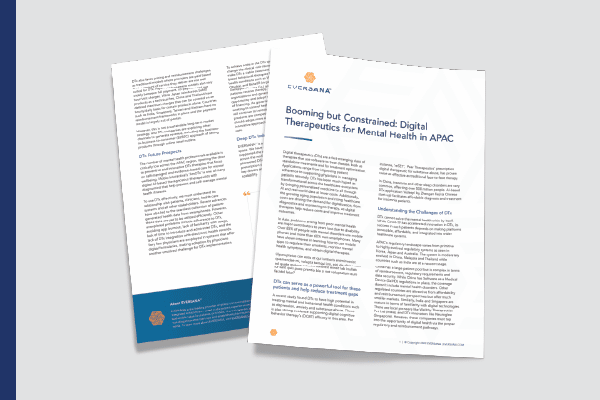
Booming but Constrained: Digital Therapeutics for Mental Health in APAC
Digital therapeutics (DTx) are a fast-emerging class of therapies that use software to treat disease, both as standalone treatments and for treatment optimization. Applications range from improving patient adherence to supporting physicians in managing patients remotely. DTx has been much hyped as transformational across the healthcare ecosystem by bringing personalized medicine to all through AI and real-world data at lower costs. Additionally, the growing aging population and rising healthcare costs are driving the demand for digitalization, from diagnostics and monitoring to therapy, as digital therapies help reduce costs and improve treatment outcomes. In Asia, problems arising from poor mental health are major contributors to years lost due to disability. Over […]

Need for RWE in Consumer Health and Its Impact in Managing Lifecycle of Consumer Health Products
Healthcare has never been more important to the world than in the past two years and it will remain central during the economic recovery. The pandemic’s impact on medical and healthcare systems has emphasized the value of real-world evidence (RWE). This value is now becoming apparent in consumer health, as well as its traditional applications in prescription (Rx) medicines. Using real-world data (RWD) and RWE to support decision-making is not new. It is increasingly used to support regulatory approvals and market access decisions for prescription (Rx) medicines. RWE has formed the basis of safety profile evaluation, risk management, and ongoing benefit-risk assessment for decades. RWE is used during Rx product […]
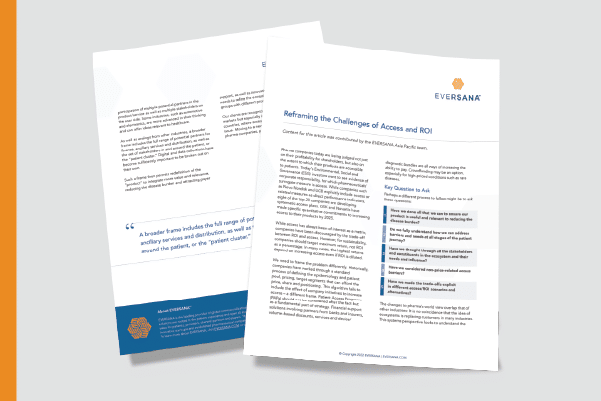
Reframing the Challenges of Access and ROI
Pharma companies today are being judged not just on their profitability for shareholders, but also on the extent to which their products are accessible to patients. Today’s Environmental, Social and Governance (ESG) investors want to see evidence of corporate responsibility, for which pharmaceuticals’ surrogate measure is access. While companies such as Novo Nordisk and UCB explicitly include access or related measures as direct performance indicators, eight of the top 20 companies are developing systematic access plans. GSK and Novartis have made specific quantitative commitments to increasing access for their products by 2025. While access has always been of interest as a metric, companies have been discouraged by the trade-off between […]
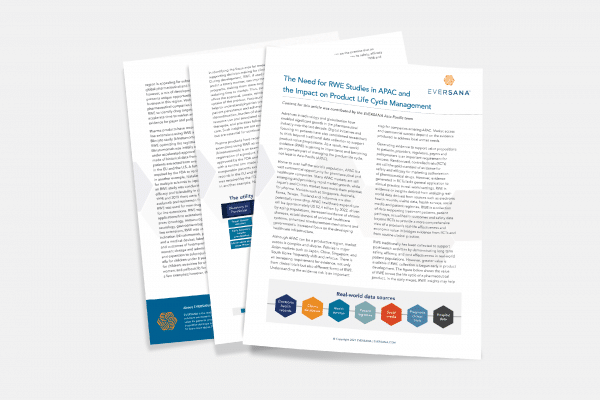
The Need for RWE Studies in APAC and the Impact on Product Life Cycle Management
Advances in technology and globalization have enabled significant growth in the pharmaceutical industry over the last decade. Digital initiatives and focusing on patients have also conditioned researchers to think beyond traditional data collection to support product value propositions. As a result, real-world evidence (RWE) is gaining in importance and becoming an important part of managing the product life cycle, not least in Asia-Pacific (APAC). Home to over half the world’s population, APAC is a vast commercial opportunity for pharmaceutical and healthcare companies. Many APAC markets are still emerging and promising rapid market growth, while Japan’s and China’s market sizes make them priorities for pharma. Markets such as Singapore, Australia, Korea, […]
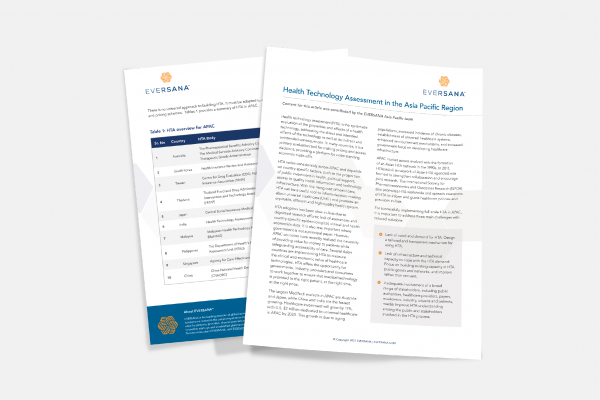
Health Technology Assessment in the Asia Pacific Region
Health technology assessment (HTA) is the systematic evaluation of the properties and effects of a health technology, addressing the direct and intended effects of the technology as well as its indirect and unintended consequences. In many countries, it is a primary evaluation tool for making pricing and access decisions, providing a platform for understanding economic trade-offs. HTA varies considerably across APAC and depends on country-specific factors, such as the proportion of public investment in health, political support, access to quality health information and technology infrastructure. With the rising cost of healthcare, HTA can be a useful tool to inform decision-making about universal healthcare (UHC ) and promote an equitable, efficient […]
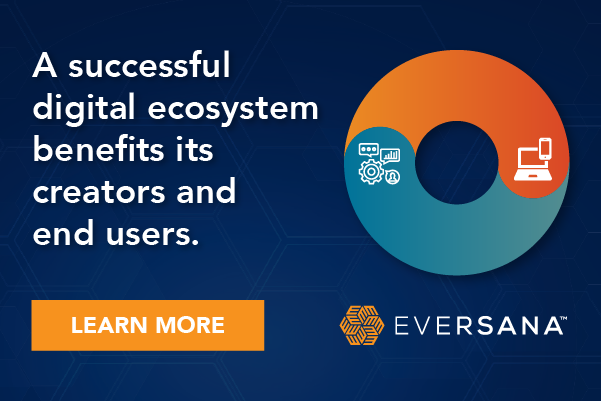
Building a Life Sciences Digital Ecosystem
In the life sciences world, we hear more and more of the requirement for digital ecosystems in various therapies. What do we mean by these, and what benefits do they provide? A digital ecosystem is a network of multiple stakeholders who collaborate to enhance delivery to patients. A healthy, sustainable ecosystem benefits patients, prepares companies to adapt to economic changes, builds patient loyalty, creates new revenue streams and lowers patient acquisition cost. Creating a sustainable digital ecosystem implies creating sustainable elements. Examples outside the life sciences industry include the following: BMW leverages its first-in-class data management, allowing its users to have premium security and privacy. Google Nest is collaborating and […]

Assessing Market Opportunity and Entry Challenges in Mental Health Disorders
Although mental health disorders affect almost 264 million people worldwide, they are often misunderstood and misdiagnosed, and access is poor. The World Health Organization (WHO) reports that 80% of people in low- and middle-income countries receive no treatment for their mental health disorders. As well as being underdiagnosed, mental health disorders are also poorly studied and an extremely challenging target for pharma companies. Obstacles include the high cost of conducting trials and generic competition. An Asian pharma company recently partnered with a small biotech firm to develop and commercialize a novel therapy for indications within depression and anxiety. The company needed to characterize the nature and scale of the opportunity […]
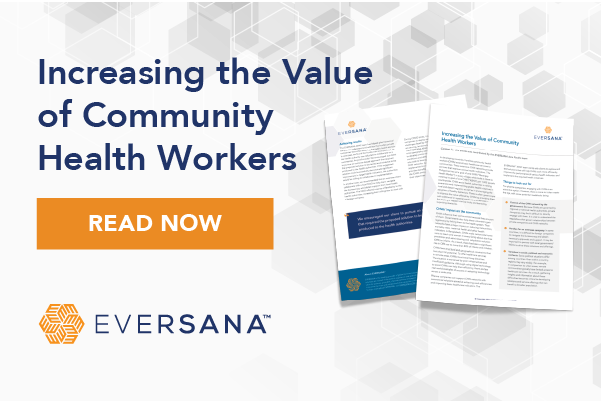
Increasing the Value of Community Health Workers
In developing countries, frontline community health workers (CHWs) extend basic healthcare services to communities. These extensive CHW networks provide services that improve various health indicators. The Philippines has set a goal of one CHW (“Barangay Health Worker”) in every village, while India is close to meeting its goal of one CHW (“ASHA”) per 1,000 people countrywide. CHWs assist health authorities in raising awareness and implementing public health initiatives in rural and distant regions, as well as in encouraging the adoption of healthy behaviors. There is often great scope to improve the value offered by CHWs by providing them with additional or superior products and services – but making it happen […]

Novel Antibiotic Opportunity in China
China, with its large population and extensive healthcare system, is the second-highest user of antibiotics in the world. Such widespread use has inevitably led to high levels of antibiotic resistance in the population. When isolated, it becomes clear that a significant majority of the infecting bacteria are gram-negative. Within these bacteria, antibiotic resistance has grown significantly to the point of becoming a serious health threat. China has responded to this increasing antibiotic resistance with preventive measures, such as setting up a surveillance network, prescription control and placing restrictions on formularies. In this restrictive environment, we reviewed the Chinese antibiotic market to gain insight into the potential market access for innovative […]
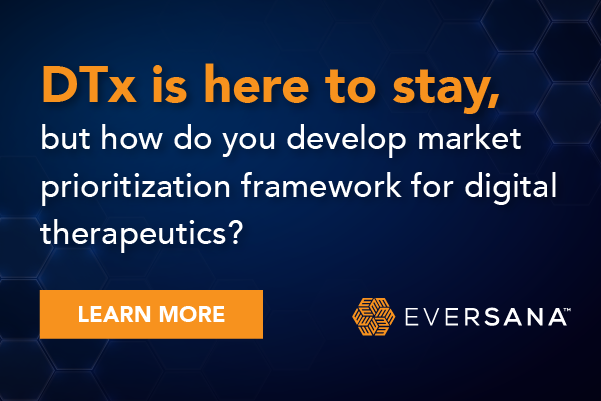
Digital Therapeutics: Where Technology Meets Healthcare
Digital health is growing rapidly across the world, supported by technologies that not only assist disease monitoring or prevention but can also reduce the healthcare burden. Digital technologies have improved equity of access and enabled European patients to monitor and self-manage their health. It has improved efficiency, effectiveness and quality of patient care while also reducing costs. Wider adoption will shape a predictive, preventative, personalized and participatory healthcare ecosystem. One arm of digital health is digital therapeutics (DTx), which are evidence-based therapeutic interventions driven by software programs. DTx are considered part of the solution for the rise in preventable chronic diseases and rising healthcare burdens. It is supported by the […]

Adapting Patient Access Programs to Asia
In Western markets, pharmaceutical companies have developed many approaches to patient access programs (PAPs), normally emphasizing initiatives that, while helping patients, also support pricing and reimbursement initiatives, such as: Early access programs before market authorization. Financial access initiatives before achieving reimbursement. Value-based contracts, managed-entry agreements or outcomes-based programs for achieving reimbursement. Non-financial assistance post-reimbursement. The need for PAPs is higher among Asian patients, and many countries have accessibility complications — transport, communication, access to healthcare — as well as affordability issues. In Asia, most PAPs target financial access with simpler schemes, such as volume-based discounts, per-patient price caps, price bundles and income-based discounts. These financial access measures are especially important […]
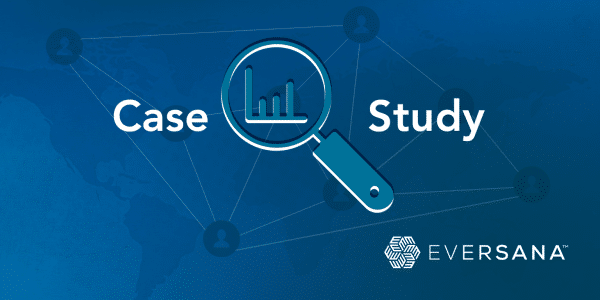
The 10-Year Test: Is It Possible to Plan Launch During Clinical Development?
Time and strategy are keys to launching in an overwhelmed, unpredictable market. Pharmaceutical companies in mid-development of a drug need to look ahead at their launch strategy options and consider what market conditions could look like by the time they’re ready to commercialize their product. By evaluating the value of an asset early in development, pharma companies can gain a better understanding of a product’s value and risk. With assessment insights, manufacturers can make informed clinical and commercial decisions moving forward. Taking advantage of far-off timelines will allow pharma companies to strategically plan where and how to spend critical investments. Read this case study to see how EVERSANA™ helped one APAC-based company assess its product’s market value and plan for a launch 10 years in the future – because it’s never too early to start planning.

Case Study: Early-Stage Asset Valuation
The rewards of developing a new drug can be very attractive but they come with inherent risks. It is important to ensure that investment decisions on clinical development are made after examining the risk profile of the drug which depends on the therapy area and the nature as well as extent of unmet needs. EVERSANA APAC Leadership recently supported a client to help them make a right decision on how to invest and when to license. Our client was developing an early stage asset in an immunology indication. The drug was still in pre-clinical stages and would take about ten years to launch in an already crowded market. Since the […]

The Importance of Digital Strategy in Pharma in the APAC Region
The Asia Pacific region continues to show great progress in digital health as pharmaceutical companies look at digital technologies as a tool to drive access and to start developing their digital strategies. To understand the strides and recent evolution of digital in pharma, our APAC team conducted a survey with top pharmaceutical companies in the region. Amardeep Udeshi, Partner at EVERSANA APAC, outlined the results of the survey and provided insightful recommendations during our Digital Symposium on how the industry is changing. Watch Amardeep’s insights and get his take on the survey results

Improving Patient Outcomes Through Digital Health
Digital applications can work cohesively with therapeutics in the treatment of a broad range of diseases, from behavioral health to chronic conditions. In an interview with Debraj Dasgupta, Head of Strategy & Go-to-Market Planning at Nippon Boehringer Ingelheim Co., Ltd., Ed Cox, Executive Vice President, Strategic Alliances & Global Head of Digital Medicine at EVERSANA, obtained an insightful perspective on digital transformation in healthcare and how pharmaceutical companies in the APAC region and across the world are leveraging digital technologies. Watch the interview in its entirety

The Digitalization of Healthcare in Asia Pacific
The digitalization of healthcare in Asia Pacific is being utilized to enhance the patient-centered approach and expanding access to health. In a candid conversation with Abhishek Shah, CEO at Wellthy Therapeutics, Ed Cox, Executive Vice President, Strategic Alliances & Global Head of Digital Medicine at EVERSANA, uncovered the current healthcare landscape and how digital strategy in pharma is evolving in the APAC region. Watch this insightful conversation:

The Regulatory Landscape in Digital Health
Despite the advances in digital health and digital therapeutics in recent years, there remains an ambiguity in the digital space and uncertainty surrounding regulation and reimbursement of digital technologies applied to pharma, biopharma and medical device companies. In an insightful conversation that was part of EVERSANA’s Digital Symposium, Ed Cox, Executive Vice President, Strategic Alliances & Global Head of Digital Medicine, and Martin Culjat, Sr. Vice President, Regulatory Innovation & Digital Medicine, discussed the use of digital technologies in pharma and the regulations surrounding it. Watch the full conversation:

Access to Technology and the Rise of Digital Health in Asia Pacific
The access to technology, development of telehealth and evolution of digital therapeutics are thriving in Asia Pacific; and pharmaceutical companies are levering the momentum to reach to a broader segment of the patient population. Ed Cox, Executive Vice President, Strategic Alliances & Global Head of Digital Medicine at EVERSANA, interviewed Anish Shindore, Head of Digital Therapeutics at Sanofi, during our Digital Symposium to understand the critical aspects of the use of digital technologies by pharma companies in the Asia Pacific region. Watch the interview now:

Digital Innovation in Asia Pacific
Digital medicine and digital therapeutics are transforming the healthcare industry by changing the care delivery format, and they have the potential to improve patient adherence and outcomes. In our recent Digital Symposium, Ed Cox, Executive Vice President, Strategic Alliances & Global Head of Digital Medicine at EVERSANA, interviewed David Keene, CEO at IntroSpect Digital Therapeutics & Lead, Digital Therapeutics at ATAI Life Sciences, and they looked at the evolution of digital therapeutics and the shift of the use of digital technologies in healthcare. Furthermore, Ed and David highlighted the trends and innovations in digital health happening in Asia Pacific, pointing out the barriers, opportunities and path forward. Watch the interview:

Outlook: Digital & Pharma in Asia Pacific
Asia Pacific is one of the fastest-growing regions for digital innovation in the pharmaceutical and biotechnology industries. Its promising outlook is mainly driven by necessity, commercial flexibility and a broad talent pool. In a candid conversation broadcasted during the EVERSANA’s Digital Symposium, Ed Cox, Executive Vice President, Strategic Alliances & Global Head of Digital Medicine, and Ravi Visweswara, Executive Vice President at EVERSANA APAC, reflected on all the changes and trends in the use of digital technology, providing insightful remarks and an outlook into the future of digital in pharma in Asia Pacific. The two industry experts brought a holistic view of digital health in the pharmaceutical sector and highlighted […]

Leading and Decision-Making in Uncertain Times
By definition, leaders must have followers, who are defined as people who must be shown the way. While this is within most leaders’ grasps when the road ahead is straight and wide and the destination is visible, more is demanded of them when the road splits, narrows and dusk falls. The current crisis presents special challenges to business leaders who have experienced largely smooth sailing for the longest bull market in history. Used to relying on historical data to project the future and to relatively predictable competitive and regulatory events in the world of operations, pharma’s leaders have focused on addressing more strategic challenges, adjusting corporate capability, capacity and culture […]
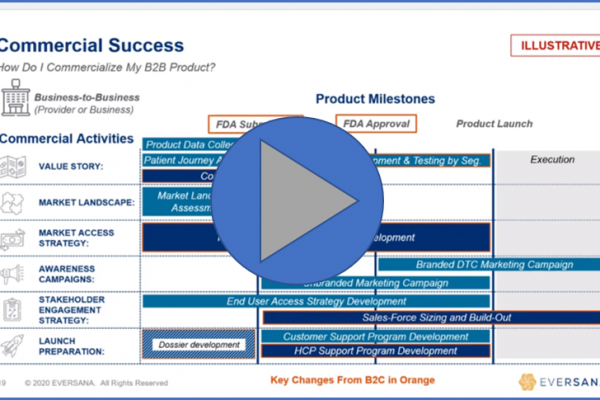
Realizing Value from Digital in the Healthcare Environment [Webinar]
[WEBINAR – 20 MINUTES] The advancements of Digital Therapies are promising but commercial success is not always guaranteed. This presentation explores the pitfalls and challenges of selling products into the uniquely complicated and regulated healthcare market. It will lay the groundwork for digital companies to have successful commercial strategies and be able to: Answer questions like: What is my commercial model? What is my pricing model? How are payers thinking about my disease? Who pays today? Will I get coverage? How does a doctor’s prescription turn into a patient’s download and use? What answers do I need now vs. later? Download the slides OR view the 20 minute webinar.
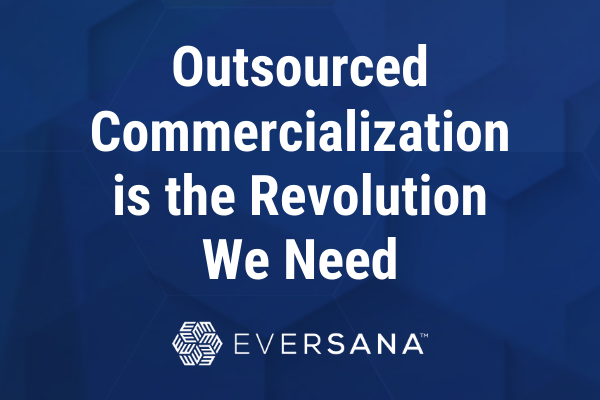
The New Roaring 20s: How Outsourced Commercialization is the Revolution We Need
The “Great Gatsby Era” was an exciting time of new prosperity, infinite creativity and dramatic social change. Long-standing social norms and traditions gave way to the “mass culture” and consumerism that modernized American society. “What will they think of next?” was a popular expression that defined the era. On the 100-year anniversary of this revolutionary decade, the pharma industry should take note: breaking from tradition is the catalyst for real, long-lasting transformation. Innovative therapies require innovative thinking. In just the past 10 years, we’ve seen both clinical and manufacturing outsourced to single partners who successfully reduced costs, minimized risk, and maintained product integrity. Commercialization, on the other hand, is lagging […]
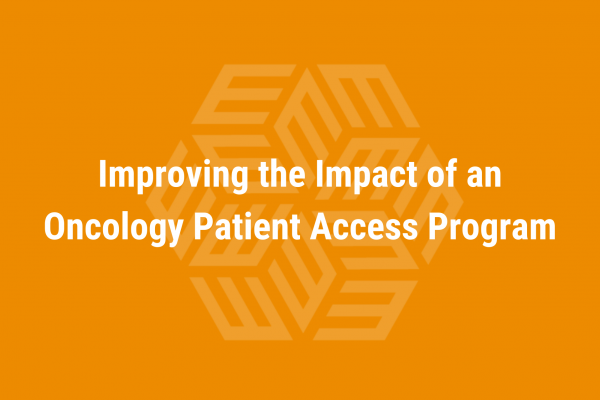
Improving the Impact of an Oncology Patient Access Program
Our client, a specialty pharmaceutical company focused on the research and development of new therapies in two high-cost complex drug categories, sought to benchmark its patient assistance program against those of its competitors in order to improve relationships within target oncologists’ offices. The Challenge The client needed to assess the image of its patient assistance program among oncologist, practice manager, and specialty pharmacy partners. Specifically, our client wanted to: Benchmark customer perceptions of its patient assistance program versus those of its competitors, Assess the impact of the program on patients and physicians, Identify unmet needs of patient services program offerings, and Identify opportunities to enhance and improve patient services offerings. […]
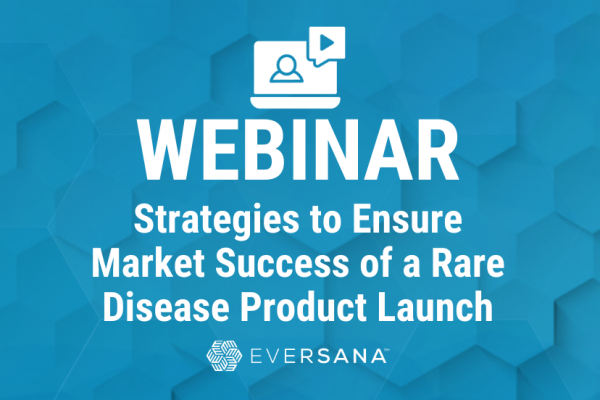
Strategies to Ensure Market Success of a Rare Disease Product Launch
Small patient populations, complex administration, high costs of therapies, and government policy interventions are just a few obstacles in rare disease. EVERSANA’s Managing Director, Bill O’Bryon, and Senior Director, Diann Johnson, outline key insights to consider in your launch strategy: Market dynamics impacting rare disease therapies The entire rare community: patients, caregivers, providers & advocates Payer landscape and engagement Patient experience Stakeholder relationships Watch the Webinar: Strategies to Ensure Market Success of a Rare Disease Product Launch
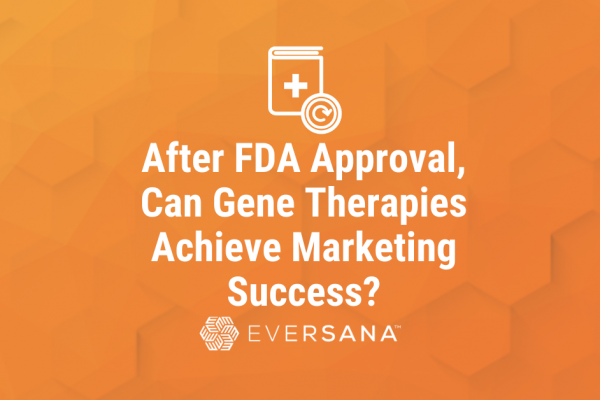
After FDA Approval, Can Gene Therapies Achieve Marketing Success?
Without a doubt, gene therapy is transforming healthcare by revolutionizing patient care from conventional treatment models to curative therapy models. There are more than 7,000 distinct types of rare and genetic diseases and 400+ million individuals suffering from a rare disease. With a market that is fragmented, there is a need for an innovative, end-to-end commercial solution to support these new therapies and lead the pharmaceutical product lifecycle from clinical trial recruitment though commercialization. In this point of view published in the special November/December 2020 Preview issue of PharmaVOICE, Greg Skalicky, Chief Revenue Officer, discusses what is needed for gene therapies to succeed after FDA approval. To read the article […]
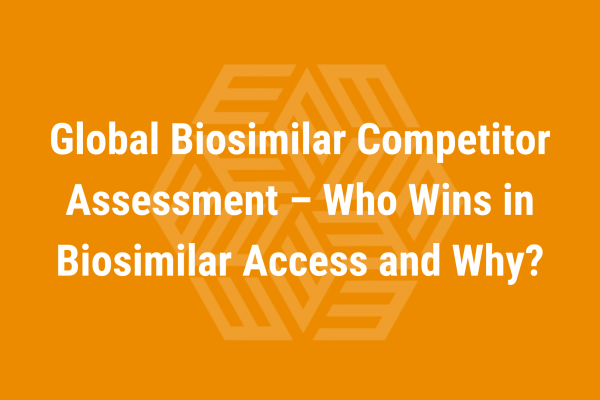
Global Biosimilar Competitor Assessment – Who Wins in Biosimilar Access and Why?
The introduction of biosimilar products has created interesting changes in payer behavior across the global markets. For both innovator and biosimilar companies, it has been an effort to understand the demands of payers and succeed in what looked like a ‘winner-takes-all’ opportunity. As the first round of biosimilar introductions has passed, there are some interesting findings across the western pharmaceutical markets. Biosimilar Competition Reveals Unique Buyer Types Among European and US Stakeholders EVERSANA identified two unique buyer types when conducting a segmentation analysis based on the reaction of EU and US customers to biosimilar competition and company performance. Economic buyers (e.g., France, Germany, and select payers of the US) treat […]

Innovative Therapies Call for an Integrated Drug Safety and Compliance Model
In this article, Herbert Lee, PharmD, Senior Vice President, Medical Communications and Pharmacovigilance, makes the case for an integrated approach to ensuring the safe and effective use of medications by patients. From emerging therapies to innovative technologies, the healthcare industry is changing – demanding that we do business differently. Working in one of the most regulated industries, we need to understand the complexities of developing products/services that meet patient need and help improve the health and safety of the public. Safety and compliance are important areas of focus in every industry I can think of and especially in life sciences. As the global environment evolves, so must our models for […]

Gene Therapy for Rare Disorders
With only three approved products in the marketplace, how do we build a regenerative medicine ecosystem that delivers more value to patient’s faster?
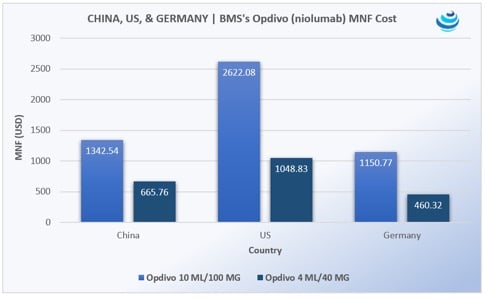
‘Tis the season for pharma in China, as the government expedites uptake of new urgently needed drugs
PRICENTRIC BRIEF: Universal health insurance coverage for 1.3 billion people means China must increase uptake of “clinically urgently needed new drugs” already approved in the US, EU, and Japan Mostly oncology products are being imported, along with HIV/AIDS medicines Pharma is agreeing to steep discounts to be reimbursed on China’s national drug lists THE DETAILS In 2016, China announced that it would be merging the New Rural Cooperative Medical Scheme (NRCMS) and Urban Employee Basic Medical Insurance (UEBMI) to form an integrated system of basic medical insurance for both rural and urban residents, as part of the 2009 Health Care Reform Plan, which seeks universal coverage for 1.3 billion people […]

